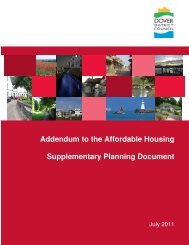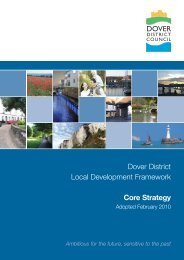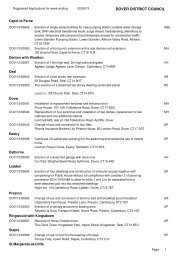Walmer Design Statement - Dover District Council
Walmer Design Statement - Dover District Council
Walmer Design Statement - Dover District Council
You also want an ePaper? Increase the reach of your titles
YUMPU automatically turns print PDFs into web optimized ePapers that Google loves.
5.1 <strong>Walmer</strong> SeafrontHistory/Evolution<strong>Walmer</strong> seafront with its two mile pebbleshoreline extends from Deal Castle to <strong>Walmer</strong>’ssouthern boundary where it is overshadowed bythe White Cliffs. The geographical features ofthis shoreline and its proximity to France and theGoodwin Sands have been major contributoryfactors to the development of the area.Shoreline, grasses and sky Historically, <strong>Walmer</strong> seafront is accepted as beingthe site where Julius Caesar landed in 55 BC andthe commemorative stone marking this occasion is sited on <strong>Walmer</strong> Green. In 1540Henry VIII built Deal and <strong>Walmer</strong> Castles as part of his defences against foreigninvasion. The castles remain significant landmarks and <strong>Walmer</strong> Castle has beenthe official residence of the Lord Warden of the Cinque Ports since the early 18 thcentury. At the beginning of the Napoleonic Wars troops were encamped in<strong>Walmer</strong> for dispatch to the continent, leading to the establishment of the militarybarracks and the naval hospital. In the mid-19th century the Coastal Blockade andthen the Coast Guard occupied a portion of the barracks. Supporting services forthe barracks were concentrated along The Strand. The retiring military and wealthyfamilies from London, with access made easier by the establishment of the railwayto Deal in 1847, built elegant seaside villas and promoted <strong>Walmer</strong>’s growth as aseaside resort.Boatmen have always been in evidence on <strong>Walmer</strong> seafront—fishing, servicingvessels in the Downs, smuggling and salvaging wrecks. The Royal National LifeboatInstitute established the lifeboat station on <strong>Walmer</strong> Green in 1856.General CharacterThe overall impression is of space and light created by wide, open skies anduninterrupted sea views. The ever changing colours of the sea and sky, the manytones of brown on the steeply shelved pebble beach and the vibrant colour fromthe broad grass sward provide a multi-coloured spectacle throughout the year. Thebeach, the promenade and <strong>Walmer</strong> Green provide a multitude of informalrecreational activities.The beach at its northern end, between the Sea Scouts’ Hut and the Downs SailingClub, remains a working beach with the clutter and smell of fishermen’s boats andhuts. The colourful paraphernalia is greatly appreciated by artists andphotographers. A well used promenade and parallel cycle path separate <strong>Walmer</strong>Green from the beach. Sited on the Green is an area set aside for recreationalactivities. On the surrounding brick wall is a mosaic on a marine theme markingQueen Elizabeth II’s Golden Jubilee in 2002. Also present are the Royal MarinesMemorial Bandstand, the Lifeboat Station and a small café.All properties along the seafront are built to maximise their view of the sea.Overlooking <strong>Walmer</strong> Green and the undeveloped shingle beach are the imposingindividually designed Victorian and Edwardian seaside villas, which line MarineRoad and The Beach. The buildings on Marine Road are detached propertiesfeaturing architectural details on the side walls, whereas terraced properties aremore common on The Beach. Many of these properties have been converted intoflats. High front walls and large shrubs accentuate privacy. A few properties ownenclosed private gardens situated on the Green.In contrast to the tranquillity of Marine Road and The Beach, The Strand is anactive commercial area overlooking the widest part of <strong>Walmer</strong> Green and theworking beach. It provides facilities for residents and tourists. All the propertiesform an interesting, undulating roofline, varying from two to four storeys. Many aretall narrow buildings with ground floor shops and with accommodation above, aresult of speculative building. St. Saviour’s Church occupies a central position and isthe site of a memorial to those who died in World War I. There are also a numberof public houses. With the advent of cars and supermarkets some of the shops havebeen converted to homes, but The Strand remains busy.6Lord Warden Avenue, Liverpool RoadHouses and boundaries, Wellington ParadeTo the south where the formal grass of <strong>Walmer</strong> Green ends the shingle supports avivid display of wildflowers and native grasses. This stretch of the promenade,
















